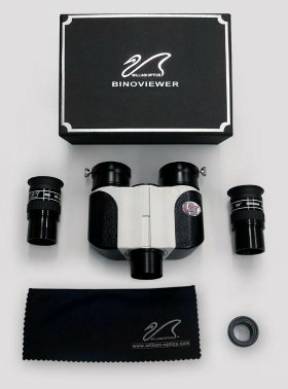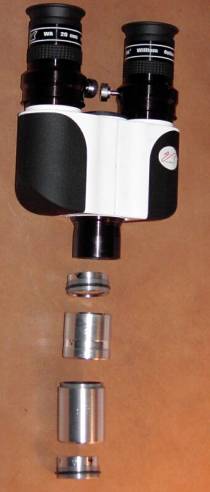|
My Foray Into Binoviewing It was
at the 2004 Winter Star Party that I had my first memorable experience with
binoviewers (BV’s). The BV’s were made by Denkmeier, and coupled with a
20” truss tube dob/newt, they afforded an incredible view of the Moon. The
optical effect of using both eyes, enhanced by steady air above the Florida
Keys, provided a credible spaceship effect that carried over to subsequent
fabulous views of Saturn and Jupiter. Though
similar in concept, unlike binoculars which provide each eye with a dedicated
light source, binoviewers split the light fed through a telescope’s focuser,
via a prism, to provide an identical image to each ocular. This light division
naturally makes for a dimmer image, as seen by each eye, but that disadvantage
is mostly offset by having both eyes sending signals to the brain which does a
fine job of synching the best of two views into one optimum picture. Since
that Florida session, however, later binoviewing opportunities failed to evoke
any real emotional response. It could have been due to unsuitable targets or
perhaps my enthusiasm had waned while waiting for those ahead of me to make the
mandatory ocular adjustments – adjustments I’d have to make myself before
seeing anything. It was a pleasant surprise, then, when a chance encounter at
the David Dunlap Observatory managed to dislodge my indifference. Within
sight of the observatory’s 74” reflector, members of the RASC Toronto Centre
had kindly set up scopes for the public. The owner of a 4” Astro-Physics
refractor, coupled to an unknown make of binoviewer, invited me to “take a
look” and there it was; the Moon, much as it had appeared to my bino-virgin
eyes years ago. The sensation of hang-gliding over the craters was not quite so
pronounced as it had been with the 20” Starmaster, yet the sharp detail and
three dimensional perception was close enough to illicit that old excitement. My
wife, Gail, liked it too – always a good sign when something like this catches
my attention. The
next week, a little web-surfing revealed that Denkmeier was offering a
stripped-down version of their deluxe BV package; basically, just the main unit
without accessories for under $500. One characteristic of binoviewers is that
they extend a scope’s light path by a few inches. A selling point for
Denkmeier is having a light path shorter than that of their competitors. The
small difference has been known to alleviate an in-focusing problem that can
plague Newtonian scopes – but not always. Further
research would soon uncover a William Optics (WO) BV package consisting of the
main unit, a pair of 20mm eyepieces (ep’s), and a 1.6x Barlow advertised to
help “most” Newtonians achieve focus. With a list price of $229, I figured
I’d found just the thing for Gail to buy for my birthday. A quick e-mail to
her work address conveyed the good news. Her response doesn’t really
contribute to the story so I’ll just add that a call to Khan Scope ensured
they had a few sets in stock, and a weekend drive to Toronto soon followed.
Sold off
the shelf in an attractive presentation box, the various parts are
well-protected with dense foam. William Optics has a reputation for quality
equipment, and the fit, finish, and feel of the main unit and SWAN eyepieces
were right in line. There are a number of companies now offering similar BV’s,
often outsourcing from the same manufacturers, however choices for eyepieces,
diopter adjustments, prisms, or design of the ocular retainers can make a
difference. In the budget-priced category, William Optics seems to have made the
right ones. First
light confirmed my suspicion that the bare unit would not focus in my 6” f8
reflector. In fact, not even the supplied 1.6x barlow helped much. I had read
that the end piece of a Meade 140 apochromatic 2x barlow would sometimes remedy
the situation. I had one. It didn’t. I could have been disappointed but really
wasn’t. This was something I’d expected and still had a couple of cards left
to play. My first
option was to try Gail’s Starblast; a 4.5” f4 reflector with a short
focuser. That, in combination with the Meade barlow end piece, brought success.
After some fiddling, Arcturus merged and came into focus as did Albireo. We also
had a quick look at M57, the Ring nebula. Despite the scope’s small aperture,
and the high humidity that night, the view was promising enough to pursue the
second option which was to purchase a set of correctors, recommended on an
online astronomy forum, from Siebert Optics. Harry
Siebert has either done a nice job of personalizing his automatic e-mail
replies, or he prides himself on staying in touch. I had responses to my queries
within 24 hours and when my order was ready, about three weeks later, I was
provided with a tracking number so I could follow the shipment online. To view
Siebert’s full range of products, go to www.siebertoptics.com
. The
recommended corrector package for my set-up consists of two short, threaded,
aluminum tubes, two threaded aluminum cells with lenses, and two rubber “O”
rings. Fully assembled, they add 2 ľ” (7cm) to the shaft of the BV and
compensate for the focuser not being able to rack down enough to achieve focus.
Although
the corrector package would increase my binoviewing cost by $179 there is added
value in that it can provide a range of three different magnifications, thereby
saving me the cost of two additional sets of matched eyepieces. The
BV package came with a quality pair of WO Swan 20mm eyepieces with 17mm of eye
relief which, if you roll down the eyecups, is enough to let you keep your
glasses on. With the
lowest power corrector combination of 1.25x, this gives my scope a field of view
of nearly a full degree – perfect for viewing the complete surface of the
Moon. Rearrange the pieces and you can increase the power by 2x or 3.5x, all the
while enjoying the nice eye relief of the 20mm oculars. While
the image is brought to initial focus with the focuser knob, each eyepiece
holder has a diopter adjustment to provide a fine focus for each eye. The
holders also employ a compression ring system to keep the eyepieces perfectly
centered. Compared
to a single eyepiece in the focuser, the use of BV’s means an extra weight
consideration of 1 – 1 1/2lbs (500-700kg). This can affect the balance of your
scope, particularly if it is the free-moving Dobsonian variety. This problem
I’d had to solve, previously, when I started using Pentax six element ep’s.
For a counterbalance I attached a couple of 2lb (1000g) flexible ankle weights,
to the bottom of the OTA, with Velcro straps. My solution for the binoviewer
set-up, therefore, was just to add another ankle weight for a quick and easy
fix. First
light came on November 19th. The evening was cool and breezy yet we were
sheltered in the dobservatory and the first quarter Moon occupied a convenient
patch of sky. Within minutes I had everything set up and the desired target in
view. A turn of the focuser knob and a beautifully cratered moonscape snapped
into sharp relief. A small adjustment of each diopter fine-tuned the image for
each eye and there, at last, was the spaceship sensation I’d been hoping for.
The unit’s Bak-4 prism ensured bright, contrasty images and the comfort of
using both eyes was marvelous – well worth the price of admission. Mentally,
I did a little math and added the cost of the BV package ($229 + $32.06 tax) to
the shipped cost of the correctors ($154.00 + $25 duty & handling) for a
total of $440.06. Even at that price I consider the bundle an absolute bargain,
especially when compared to what Denkmeier offers in that range. So
have I become a fully-indoctrinated binoviewer? Well, yes. And no. It may be a
factor of aperture but, where BV’s excel with the brighter objects; on dimmer
DSO’s a pair of garden variety Plossl’s, forced to share a limited supply of
photons, won’t provide the same contrast as a single high-end eyepiece.
Another mark against BV’s is that they’re not really star party friendly.
When you have people lined up, any extra adjustment required to give each person
the optimum view takes precious time. In those situations, I’d forsake the
two-eyed WOW factor for the efficiency and ease of use of a pleasing monocular
view. Finally,
the laws of astro-physics dictate that the expansion of my optics collection
must be offset by a new eyepiece case. But, hey, as the Universe expands then so
must my astro-gear. Call it another practical example of relativity.
Copyright - Glenn Muller, 2008
|

